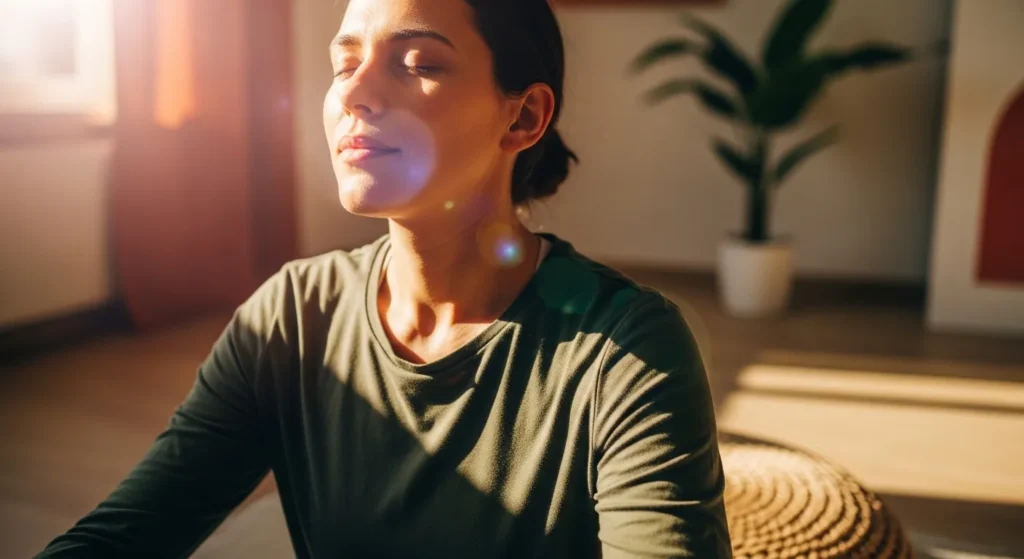Best Breathing Exercises: 6 Poweful Techniques For Managing Stress

What if the most powerful tool for managing stress, boosting energy, and improving focus was literally right under your nose?
I used to think breathing exercises were just hippie nonsense until a particularly stressful week left me feeling completely burned out. My heart was racing, sleep was elusive, and I couldn’t focus on anything for more than five minutes.
That’s when my doctor suggested something unexpected: “Try some deep breathing exercises.” I almost laughed. But desperate times called for desperate measures, and what I discovered changed everything.
Within just three days of practicing the best breathing exercises consistently, my resting heart rate dropped, my sleep improved, and that constant knot in my chest finally loosened. The science behind why this works is fascinating—and the results are undeniable.
Breathing exercises aren’t just about relaxation; they’re about optimizing your nervous system, enhancing cognitive performance, and literally rewiring your brain for better stress resilience. These techniques work because they directly influence your autonomic nervous system—the control center for everything from heart rate to hormone production.
In this guide, we’ll explore six of the best breathing exercises backed by research, each designed for specific outcomes like reducing anxiety, boosting energy, or improving sleep. No fluff, no mystical language—just practical techniques that deliver real results.
Key Takeaways
- The best breathing exercises can shift your nervous system state in under 3 minutes
- Deep breathing exercises work by activating your vagus nerve and optimizing heart rate variability
- Different techniques serve different purposes: energy, relaxation, focus, or recovery
- Consistency matters more than duration—2 minutes daily beats sporadic longer sessions
- These techniques require no equipment and can be done anywhere, anytime
Why Your Body Craves Conscious Breathing
Let’s talk science. Most of us breathe unconsciously at about 12-20 breaths per minute, often shallow and chest-focused. This pattern keeps us in a low-grade stress state that accumulates over time.
Deep breathing exercises work by:
- Activating the parasympathetic nervous system (your “rest and digest” mode)
- Stimulating the vagus nerve, which connects your brain to major organs
- Improving heart rate variability (HRV), a key marker of stress resilience
- Increasing oxygen efficiency and reducing cortisol levels
Research from Harvard Medical School shows that controlled breathing can lower blood pressure, reduce anxiety, and improve cognitive function within minutes. A Stanford study found that just 5 minutes of specific breathing exercises can be more effective than meditation for immediate stress relief.
The bottom line? Your breath is the fastest way to hack your nervous system and optimize your mental state.
6 Best Breathing Exercises for Different Goals
1. Box Breathing (The Stress Crusher)
This is hands-down one of the best breathing exercises for immediate anxiety relief. Navy SEALs use this technique to stay calm under extreme pressure.
The method:
- Inhale for 4 counts
- Hold for 4 counts
- Exhale for 4 counts
- Hold empty for 4 counts
- Repeat 8-12 cycles
When to use: Before stressful meetings, during anxiety spikes, or anytime you need instant calm
Why it works: The equal counts create rhythmic coherence that balances your nervous system. The holds give your body time to absorb oxygen and activate calming neurotransmitters.
Pro tip: If 4 counts feels too long, start with 3. If it feels too easy, increase to 5 or 6. The key is maintaining the equal ratio.
2. 4-7-8 Breathing (The Sleep Inducer)
Dr. Andrew Weil calls this technique a “natural tranquilizer for the nervous system.” It’s perfect for falling asleep faster or deep relaxation.
The pattern:
- Inhale through nose for 4 counts
- Hold breath for 7 counts
- Exhale through mouth for 8 counts (making a whoosh sound)
- Repeat 4-8 cycles
Best timing: 30 minutes before bed or during the day when you need to downshift
The science: The extended exhale (8 counts) activates your parasympathetic nervous system more powerfully than the inhale, triggering deep relaxation responses.
Warning: You might feel slightly lightheaded initially—this is normal as your body adjusts to increased oxygen levels.
3. Energizing Breath (The Natural Stimulant)
When you need an energy boost without caffeine, this technique from yoga pranayama delivers immediate alertness.
The technique:
- Sit tall with spine straight
- Breathe in and out rapidly through your nose (like bellows)
- Keep mouth closed, breaths should be short and sharp
- Start with 30 seconds, build to 2 minutes
- End with 3 deep, slow breaths
Perfect for: Morning activation, midday energy crashes, pre-workout preparation
What happens: Rapid breathing increases oxygen to your brain, stimulates your sympathetic nervous system, and releases energizing hormones naturally.
Safety note: Stop if you feel dizzy and never practice while driving or standing.
4. Coherent Breathing (The Performance Optimizer)
This is one of the best breathing exercises for improving focus, decision-making, and overall cognitive performance.
The method:
- Breathe in for 5 seconds
- Breathe out for 5 seconds
- No pause between breaths
- Continue for 5-20 minutes
- Aim for about 6 breaths per minute
When to practice: Before important tasks, during work breaks, or when you need sustained focus
The magic: This rhythm optimizes heart rate variability and creates coherence between your heart, mind, and emotions. Elite athletes and executives use this technique to enhance performance under pressure.
5. Extended Exhale (The Anxiety Antidote)
When panic or overwhelm hits, this simple technique can restore calm in under 3 minutes.
How it works:
- Inhale naturally through your nose
- Exhale slowly through your mouth, making it twice as long as your inhale
- If you inhale for 3 counts, exhale for 6
- Focus on completely emptying your lungs
- Repeat 10-15 times
Why it’s effective: Extended exhales directly stimulate your vagus nerve, sending a “safety signal” to your brain that reduces stress hormones and calms your entire system.
Best use: During acute stress, before difficult conversations, or when you feel reactive rather than responsive.
6. Alternate Nostril Breathing (The Brain Balancer)
This ancient technique balances the left and right hemispheres of your brain, improving focus and mental clarity.
The process:
- Use your right thumb to close your right nostril
- Inhale through your left nostril for 4 counts
- Close left nostril with ring finger, release thumb
- Exhale through right nostril for 4 counts
- Inhale through right nostril for 4 counts
- Close right nostril, release left
- Exhale through left nostril for 4 counts
- This completes one cycle—repeat 5-10 times
When to practice: Before creative work, studying, or when you need mental clarity
The science: Each nostril connects to different brain hemispheres. Alternating stimulates both sides, creating neural balance and enhanced cognitive function.
Matching Techniques to Your Needs
Different situations call for different breathing exercises. Here’s your quick reference guide:
| Situation | Best Technique | Duration | Expected Result |
| High stress/anxiety | Box Breathing | 3-5 minutes | Immediate calm |
| Can’t sleep | 4-7-8 Breathing | 4-8 cycles | Deep relaxation |
| Low energy | Energizing Breath | 30 seconds-2 minutes | Natural alertness |
| Need focus | Coherent Breathing | 5-10 minutes | Enhanced performance |
| Feeling reactive | Extended Exhale | 2-3 minutes | Emotional regulation |
| Mental fog | Alternate Nostril | 5-10 cycles | Mental clarity |
Building Your Daily Breathing Practice
The best breathing exercises only work if you actually do them. Here’s how to build a sustainable practice:
Week 1: Choose one technique, practice 3 minutes daily at the same time Week 2: Add a second technique for different situations
Week 3: Experiment with timing—morning vs. evening practices Week 4: Start using techniques reactively when you need them
Micro-practices that compound:
- 3 box breaths before checking email
- Coherent breathing during your commute
- Extended exhale before responding to stressful texts
- 4-7-8 breathing while waiting in lines
Common Mistakes to Avoid
Forcing the breath: Your breathing should feel natural and comfortable. If you’re straining, slow down or reduce the counts.
Expecting instant perfection: Like any skill, breathing exercises improve with practice. Be patient with yourself.
Only practicing when stressed: Preventive practice is more effective than reactive practice. Build the skill when you’re calm.
Holding unrealistic expectations: These are tools, not magic bullets. They work best as part of a comprehensive wellness approach.
The Science Behind Why This Works
Research from institutions like Stanford, Harvard, and the HeartMath Institute shows that controlled breathing:
- Reduces cortisol (stress hormone) by up to 25%
- Improves heart rate variability, a key longevity marker
- Increases GABA, your brain’s primary calming neurotransmitter
- Activates the vagus nerve, improving inflammation and immune function
- Enhances cognitive flexibility and emotional regulation
The compound effect: Regular practice literally rewires your nervous system for better stress resilience, improved focus, and enhanced overall well-being.
Tools to Enhance Your Practice
While deep breathing exercises require no equipment, some tools can support your journey:
Free resources:
- Breath pacer apps: Help maintain consistent rhythms
- Insight Timer: Free guided breathing sessions
- YouTube: Search “breathing exercises” for video guidance
Helpful additions:
- Heart rate variability monitors: Track nervous system improvements
- Meditation cushions: Support comfortable positioning
- Essential oils: Enhance relaxation during practice
A simple smartphone timer or the built-in breathing feature on Apple Watch can help you maintain consistent rhythms without overthinking.
Beyond the Basics: Advanced Applications
Once you’ve mastered these best breathing exercises, you can explore advanced applications:
- Pre-performance: Use energizing breath before workouts or presentations
- Recovery enhancement: Practice coherent breathing post-exercise
- Conflict resolution: Extended exhale before difficult conversations
- Creative flow: Alternate nostril breathing before brainstorming
The beauty of breathing exercises? They’re always available, cost nothing, and become more powerful with consistent practice.
Making It Stick: Your Action Plan
Today: Choose one technique that resonates with your biggest need This week: Practice the same technique daily to build familiarity This month: Add techniques as needed for different situations Long-term: Let breathing become your go-to tool for state management
Remember: The best breathing exercises are the ones you actually use. Start simple, stay consistent, and let the results speak for themselves.
Your breath is the bridge between your conscious and unconscious mind, between stress and calm, between reaction and response. These six techniques give you conscious control over one of your body’s most powerful self-regulation systems.
Want to explore more nervous system optimization techniques? Check out our comprehensive guide on building stress resilience through biohacking. And if you’re curious about combining breathwork with other wellness practices, our morning routine optimization article shows you how to stack habits for maximum impact.
Your transformation is just one conscious breath away.
Disclaimer: The information provided is for educational purposes only, not a substitute for professional medical advice. Always consult a healthcare professional.







